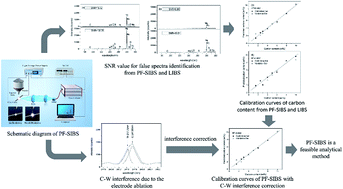当前位置:
X-MOL 学术
›
J. Anal. At. Spectrom.
›
论文详情
Our official English website, www.x-mol.net, welcomes your feedback! (Note: you will need to create a separate account there.)
Real-time measurement of constituents in solid materials using particle flow spark induced breakdown spectroscopy
Journal of Analytical Atomic Spectrometry ( IF 3.4 ) Pub Date : 2018-04-24 00:00:00 , DOI: 10.1039/c8ja00075a Shunchun Yao 1, 2, 3, 4, 5 , Jialong Xu 1, 2, 3, 4, 5 , Xiang Zhang 3, 4, 6 , Lifeng Zhang 1, 2, 3, 4, 5 , Zhimin Lu 1, 2, 3, 4, 5 , Jidong Lu 1, 2, 3, 4, 5
Journal of Analytical Atomic Spectrometry ( IF 3.4 ) Pub Date : 2018-04-24 00:00:00 , DOI: 10.1039/c8ja00075a Shunchun Yao 1, 2, 3, 4, 5 , Jialong Xu 1, 2, 3, 4, 5 , Xiang Zhang 3, 4, 6 , Lifeng Zhang 1, 2, 3, 4, 5 , Zhimin Lu 1, 2, 3, 4, 5 , Jidong Lu 1, 2, 3, 4, 5
Affiliation

|
This paper presents an analytical scheme that combines spark-induced breakdown spectroscopy with particle flow (PF-SIBS) for the real-time measurement of the constituents in powdered materials. With high voltage power supply instruments, a vibrational feeder and a spectrometer, the measuring system is low-cost and robust. To demonstrate its applicability, particle samples with varied carbon content were tested in LIBS and PF-SIBS for the comparison of their relative standard deviation (RSD), false spectra ratio, signal-to-noise ratio (SNR) and calibration results. The RSD of the C I 247.86 nm line in LIBS ranged from 35.72% to 62.51% for eight samples, while for PF-SIBS it ranged from 19.63% to 46.57%. The SNR of the Si I 288.15 nm was set as the index for the partial breakdown spectral identification and about 10% of the spectra were identified as false in LIBS, while all the spectra were identified as true spectra in PF-SIBS. The SNR of the C line in PF-SIBS was enhanced by 4 times as compared with LIBS. Since lines emitted from the tungsten electrode are inevitable, a correction method was employed to correct the interference between the C I 247.86 nm and W II 247.77 nm lines. The correlation coefficient, R2, of the linear multivariate calibration of LIBS was 0.957, while that of PF-SIBS was greater than 0.990 and can reach 0.995 after C–W interference correction. With interference correction in PF-SIBS, the average absolute error of the sample validation was 0.38% and the limit of detection (LOD) was 0.46%. These results demonstrate the feasibility of PF-SIBS as a powerful detection technology for the real-time measurement of the constituents in powdered materials and the interference correction can improve the measurement effect at low concentration.
中文翻译:

使用粒子流火花诱导击穿光谱法实时测量固体材料中的成分
本文提出了一种结合火花感应击穿光谱和颗粒流(PF-SIBS)的分析方案,用于实时测量粉末材料中的成分。借助高压电源仪表,振动馈线和光谱仪,该测量系统不仅成本低廉,而且坚固耐用。为了证明其适用性,在LIBS和PF-SIBS中对碳含量不同的颗粒样品进行了测试,以比较其相对标准偏差(RSD),假光谱比,信噪比(SNR)和校准结果。对于八个样品,LIBS中的CI 247.86 nm线的RSD为35.72%至62.51%,而PF-SIBS的RSD为19.63%至46.57%。Si I 288的SNR。将15 nm设置为部分击穿光谱识别的指标,在LIBS中将约10%的光谱识别为假,而在PF-SIBS中将所有光谱识别为真实光谱。与LIBS相比,PF-SIBS中C线的SNR提高了4倍。由于从钨电极发出的线是不可避免的,因此采用校正方法来校正CI 247.86 nm和W II 247.77 nm线之间的干涉。相关系数LIBS的线性多元校正的R 2为0.957,而PF-SIBS的线性多元校正大于0.990,经过C–W干扰校正后可以达到0.995。通过PF-SIBS中的干扰校正,样品验证的平均绝对误差为0.38%,检出限(LOD)为0.46%。这些结果证明了PF-SIBS作为一种强大的检测技术,可以实时测量粉末材料中的成分的可行性,并且干扰校正可以改善低浓度下的测量效果。
更新日期:2018-04-24
中文翻译:

使用粒子流火花诱导击穿光谱法实时测量固体材料中的成分
本文提出了一种结合火花感应击穿光谱和颗粒流(PF-SIBS)的分析方案,用于实时测量粉末材料中的成分。借助高压电源仪表,振动馈线和光谱仪,该测量系统不仅成本低廉,而且坚固耐用。为了证明其适用性,在LIBS和PF-SIBS中对碳含量不同的颗粒样品进行了测试,以比较其相对标准偏差(RSD),假光谱比,信噪比(SNR)和校准结果。对于八个样品,LIBS中的CI 247.86 nm线的RSD为35.72%至62.51%,而PF-SIBS的RSD为19.63%至46.57%。Si I 288的SNR。将15 nm设置为部分击穿光谱识别的指标,在LIBS中将约10%的光谱识别为假,而在PF-SIBS中将所有光谱识别为真实光谱。与LIBS相比,PF-SIBS中C线的SNR提高了4倍。由于从钨电极发出的线是不可避免的,因此采用校正方法来校正CI 247.86 nm和W II 247.77 nm线之间的干涉。相关系数LIBS的线性多元校正的R 2为0.957,而PF-SIBS的线性多元校正大于0.990,经过C–W干扰校正后可以达到0.995。通过PF-SIBS中的干扰校正,样品验证的平均绝对误差为0.38%,检出限(LOD)为0.46%。这些结果证明了PF-SIBS作为一种强大的检测技术,可以实时测量粉末材料中的成分的可行性,并且干扰校正可以改善低浓度下的测量效果。



























 京公网安备 11010802027423号
京公网安备 11010802027423号